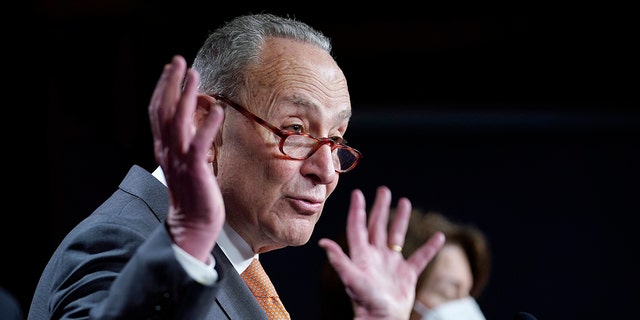Sinema’s exit from Democrats could complicate efforts to organize Senate
Arizona Sen. Kyrsten Sinema’s exit from the Democratic Party means one less Democrat in the Senate, which could complicate Majority Leader Chuck Schumer’s efforts to organize the Senate ahead of the next Congress.
The most important question is whether Sinema, who was first elected in 2018, will choose to caucus with Democrats. The Arizona lawmaker has hinted she will coalesce with Democrats within the Senate, but has not said so specifically.
“I don’t anticipate that anything will change about the Senate structure,” Sinema told Politico. “I intend to show up to work, do the same work that I always do. I just intend to show up to work as an independent.”
Caucusing with Democrats would be a big relief to that party, as it will give Schumer a 51 seat majority when the new Congress takes office in January. That would give Democrats outright control of the Senate without having to rely on the tie-breaking vote of Vice President Kamala Harris.
DEMOCRATS RE-ELECT SCHUMER AS LEADER AFTER EXPANDING SENATE MAJORITY TO 51
It would also likely give Democrats more representation on Senate committees. After the 2020 election resulted in an evenly split Senate, Schumer and Republican Leader Mitch McConnell were forced to negotiate a power-sharing agreement.
While Democrats officially held the majority because of Harris’ tie-breaking vote, Republicans were able to demand concessions since a resolution denoting how the Senate will be run needs at least 60-votes to avert a filibuster.
AFTER GEORGIA RUNOFF RESULTS, HERE’S WHAT TO EXPECT FROM SENATE, HOUSE FOR NEXT TWO YEARS
That reality gave Republicans and Democrats equal representation on Senate committees, with equal budgets and office space. The agreement also made it easier for either party to put legislation on the floor if a Senate committee deadlocked.
“Since the Senate is organized on a majority basis, Democrats would have more power over committees and legislation if the majority is 51 seats,” said a senior Democratic aide. “If it’s 50-50, the good news is that nothing changes, but that’s also not an optimal place for a party officially in control.”

Sinema’s office did not return requests for comment on this story. The White House said that Sinema’s decision to become an independent would likely have no impact on how the Senate is organized.
“We understand that her decision to register as an independent in Arizona does not change the new Democratic majority control of the Senate, and we have every reason to expect that we will continue to work successfully with her,” said White House press secretary Karine Jean-Pierre.

However, even if Sinema caucuses with Democrats, her exit from the party is likely to have other implications when it comes to votes.
Since joining the Senate in 2019, Sinema has cut a moderate profile by working with Republicans on infrastructure and immigration. The Arizona lawmaker has also rebutted calls by members of her party to scrap 60-vote filibuster threshold needed for most legislation to pass.
The independent streak was displayed over the past two years in the fight over President Biden’s $739 billion Inflation Reduction Act. Sinema opposed an initial version of the legislation because of concerns over raising taxes.
The opposition forced Democrats to abandon gutting the Trump-era tax cuts since the Inflation Reduction Act could only pass by a party-line process known as budget reconciliation.
Read the full article Here


